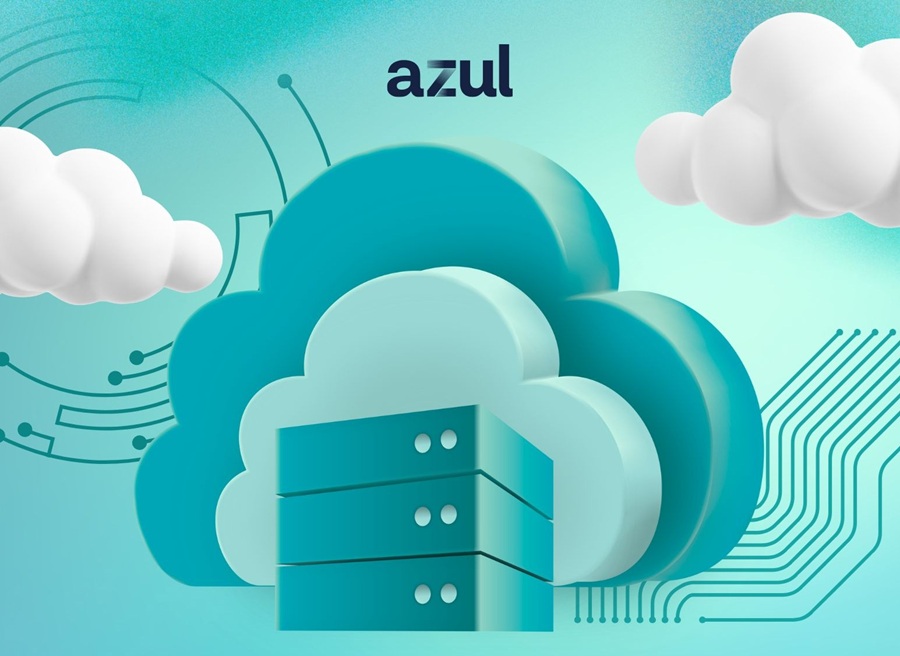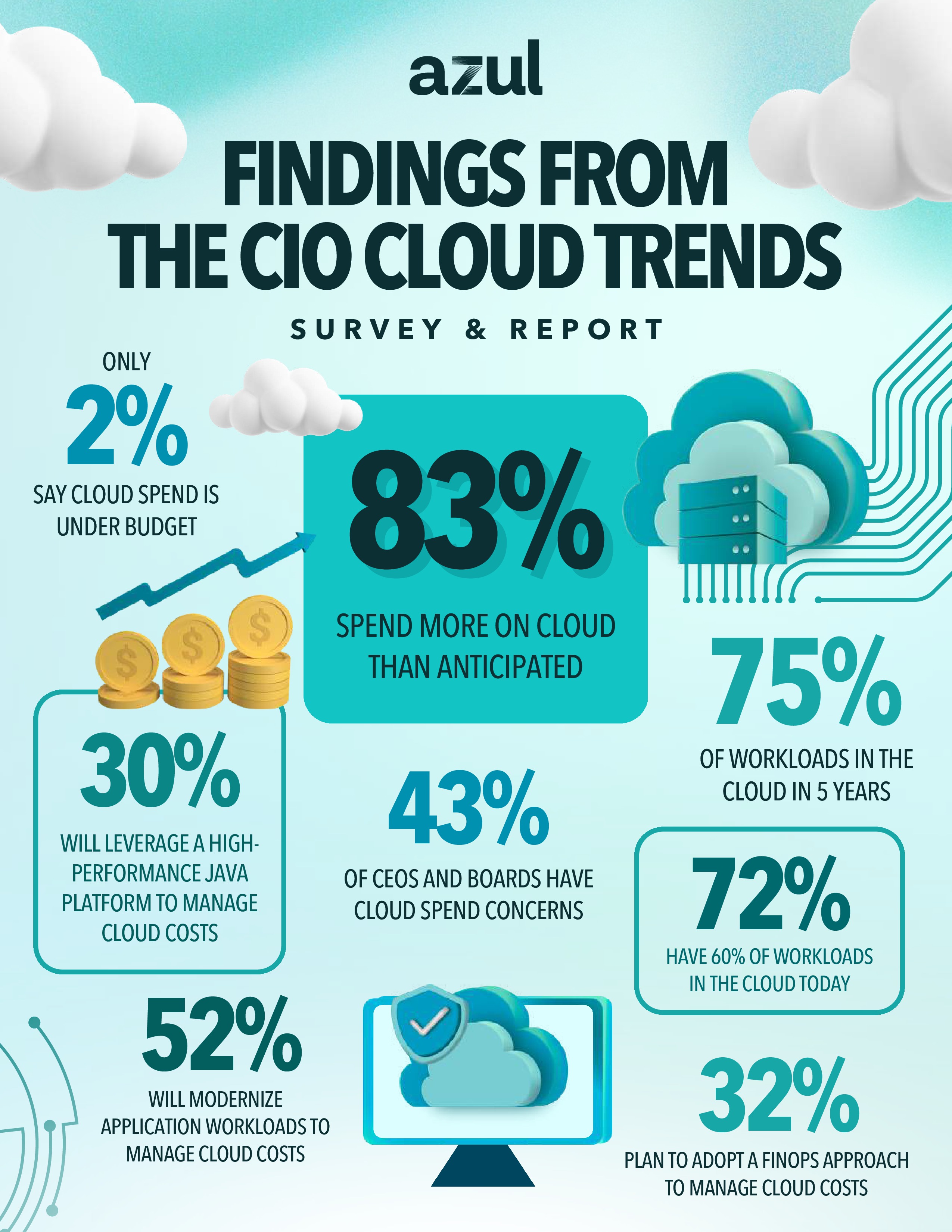As enterprises accelerate their cloud adoption strategies, CIOs are routinely exceeding their cloud budgets — a concern that's about to face additional pressure from an unexpected direction: uncertainty over semiconductor tariffs.
The CIO Cloud Trends Survey & Report from Azul reveals the extent continued cloud investment despite cost overruns, and how organizations are attempting to bring spending under control. With looming semiconductor tariffs threatening to further increase infrastructure costs, these already-challenging budget management issues will become even more critical for IT leaders to address through software optimization and other controllable factors.

Inside the Disconnect: Why Most CIOs Blow Past Cloud Budgets Yet Still See ROI
The report, based on a survey of 300 CIOs at large US companies with 500 or more employees and annual revenues exceeding $50 million, reveals a contradiction in cloud economics.
According to the findings, 83% of CIOs are overshooting their cloud infrastructure and application budgets by an average of 30%, while a mere 2% manage to stay under budget. Yet paradoxically, 80% of these same CIOs report achieving cost savings from their cloud initiatives despite the budget overruns.
This apparent contradiction — overspending yet still saving — points to a more nuanced reality of cloud economics. When CIOs report cost savings despite budget overruns, they're typically comparing cloud costs against what they would have spent on equivalent on-premises infrastructure expansion, maintenance, and staffing.
They're also factoring in less tangible benefits, such as improved business agility, faster time-to-market, and enhanced capabilities that would have been prohibitively expensive to build in-house. However, the challenge remains in accurately forecasting these costs upfront, as the dynamic nature of cloud usage, pricing models, and unforeseen requirements consistently undermines budget estimates.
This financial unpredictability hasn't gone unnoticed in boardrooms. 43% of CIOs face leadership concerns about cloud spending levels:
- 27% report their CEO or board requires "favorable market conditions" before approving cloud expansion
- 9% say leadership is flatly unwilling to approve additional expenses
- 5% face pressure to actually reduce current cloud expenditures
Yet surprisingly, the majority of leadership teams (56%) remain supportive of current spending and would approve further increases — likely because they recognize the strategic value despite the budget overruns.
Cloud Momentum Outpaces Cost Anxiety as Migration Plans Intensify
The appetite for cloud adoption shows no signs of slowing. Currently, 71% of surveyed CIOs report running more than 60% of their workloads in cloud environments. Their five-year outlook is even more cloud-heavy, with 42% planning to host 81-100% of workloads in the cloud.
This creates mounting pressure to control costs while still achieving the strategic benefits that drive cloud adoption in the first place.
Why Cloud? CIOs Point to AI, Scalability, and Cost Efficiency as Key Drivers
Several key drivers are pushing organizations further into the cloud. Topping the list are data analytics and AI/ML capabilities, with 42% of CIOs citing them as a primary reason for their cloud investments. Cost efficiency follows closely at 40%, with scalability and flexibility just behind at 39%. Improving employee productivity (32%) and ensuring business continuity and disaster recovery (25%) also play significant roles, rounding out the mix of strategic priorities that fuel continued cloud adoption.
This highlights the importance of aligning cloud strategies with both innovation objectives and financial discipline for CIOs. This ensures that investments in AI, scalability, and resilience deliver real value without incurring excessive costs.
Interestingly, priorities shift based on organizational size. Larger companies (1,000-5,000 employees) place greater emphasis on cost efficiency (43%) compared to smaller organizations (32%), suggesting that economies of scale may be more achievable for enterprises with larger cloud footprints.
How CIOs Are Trying to Control Costs
CIOs are implementing various strategies to control expenses as they face persistent budget overruns. The most popular approaches include:
- Optimizing application workloads for cloud deployment (52%)
- Using cloud provider cost management tools (51%)
- Taking advantage of enterprise discount programs (49%)
- Tracking and auditing cloud deployments (45%)
- Adopting FinOps approaches (32%)
Some organizations are exploring more technical solutions, with 30% looking at high-performance Java platforms to reduce computing waste and 29% considering ARM architectures for better price-performance ratios.
While cloud repatriation, or shifting workloads back to on-premises infrastructure, has sparked some industry debate, it remains far from the norm. Only 22% of CIOs include repatriation in their cost management plans, and just 2% report any active push from leadership to move away from the cloud. For most organizations, the focus remains on optimizing within the cloud rather than retreating from it.
Semiconductor Tariffs Threaten to Inflate Cloud Infrastructure Costs Even Further
The recently announced US Department of Commerce probe into semiconductor technology imports introduces a new variable into the cloud cost equation. The investigation encompasses chip components, chipmaking equipment, and downstream products that contain semiconductors, which translates to all the hardware underpinning cloud infrastructure.
With potential tariffs looming, data center costs are expected to rise significantly. These increases would likely ripple through the cloud service provider ecosystem, eventually reaching enterprise customers in the form of higher fees and reduced discounting.
For enterprises already struggling with cloud budget overruns, these hardware-driven cost increases could exacerbate an already challenging financial situation. While CIOs have limited control over tariff policies or the resulting hardware costs, the findings suggest they should focus even more intensely on areas they can control. Software optimization is the path forward in this uncertain economic time.
Why Software Optimization Is Essential to Surviving Cloud Cost Pressures
Cloud environments deliver transformative capabilities, but controlling their costs remains challenging. With most organizations planning to increase their reliance on the cloud over the next five years, the pressure to improve forecasting accuracy and cost management will intensify.
For CIOs caught between strategic imperatives and budget realities, finding tools and approaches that optimize cloud resources without sacrificing performance has become mission-critical. The question isn't whether cloud adoption will continue — it's how to make it financially sustainable while delivering on its transformative potential.
Balancing Innovation with Financial Discipline
As semiconductor tariffs loom, the cloud cost management challenge faced by CIOs is likely to intensify. These tariffs would directly impact the hardware infrastructure underlying cloud services, potentially driving up costs for cloud providers who may then pass these increases on to customers.
The persistent gap between expected and actual cloud costs revealed in this survey indicates that many organizations are already struggling with financial forecasting in this area. With 83% of CIOs exceeding their cloud budgets by an average of 30%, any additional cost pressures from semiconductor tariffs could worsen an already challenging situation.
CIOs should focus on areas where they can exert control. Strategies such as modernizing Java applications can reduce compute requirements by 30-50%, delivering substantial savings that can offset rising hardware costs. As one area of spending becomes less controllable due to tariffs and supply chain pressures, optimizing cloud software efficiency becomes an economic necessity for maintaining the budget while continuing cloud transformation initiatives.

